Notice of Online Archive
This page is no longer being updated and remains online for informational and historical purposes only. The information is accurate as of the last page update.
For questions about page contents, contact the Communications Division.
More than three decades ago, the arts at Lafayette needed a new home. The entirety of the department operated out of Jenks Hall, an old biology building that smelled of “monkeys and fish,” recalls Prof. Ed Kerns.
Today, Lafayette arts’ latest sanctuary – William C. Buck Hall — has opened at the bottom of College Hill. It houses state-of-the-art technology, a brand new black-box theater and a 180-seat cinema. Positioned at the nexus between Easton’s heart and the seat of its College, the Williams Arts Campus has bolstered the kinship between the College and its community.
What happened in the intervening years was organic, born out of the determination of faculty and administrators and students’ passion for the arts. It was also an ambitious vision and committed collaboration between the City, the College and the Commonwealth, an ongoing project focused on the arts, education, and economic development in Easton.
“The expansion of the Williams Arts Campus continues Lafayette’s bridge into the Easton community,” says Jennifer Kelly, director of arts and associate professor of music. “Our many arts departments and programs throughout the campus are available for our community throughout the year, and the expanding arts facilities are an example of the commitment Lafayette College has to the arts and also for strengthening our relationship with our broader community.”
Kerns, today the Eugene H. Clapp Professor of Art, had been wooed from his work as a New York City artist with the promise of building a new arts program at Lafayette – facility and all.
Between 1980 and 1984, Kerns and other art faculty built the Williams Center for the Arts, the brick and glass building on High Street that until 2001, housed music, theater, and art. At the time, it offered Lafayette’s artists what they sorely needed — stage space, places for artists to work and room for musicians to practice.
“It’s a wonderful space,” Kerns says. “But we had already outgrown it by the time we moved in.”
Michael O’Neill, associate professor and head of theater, arrived in 1992. There was no theater major or minor in those days, the program was part of the College’s English department. It began to grow in space it shared with musicians and other artists.
So, for nearly a decade, Kerns became “a shrill voice” for more room. In 1993, when Arthur Rothkopf took over as president of the College, Kerns pointed at the North Third Street corridor — the narrow band between the old stone mansions of College Hill and the then-rough-and-tumble urban center of Easton. There was a biker bar and a garage for classic cars.
“We always talked about how that area is such an important gateway,” says Mary Wilford-Hunt, director of space management, landscape and special projects. There had been a series of design proposals, including demolishing the buildings, creating green space and adding trees, or revitalizing the commercial corridor by renovating buildings for retailers.
Kerns asked for the old garage for his art students. It had functional elevators that opened on 24,000 yawning square feet where artists could work their magic.
Rothkopf relented on one condition.
“If you do that building down there,” he asked Kerns, “can you do something for the community?”
“Of course,” Kerns said.
The College employed Joe Biondo, a world-famous architect living in the Lehigh Valley. Biondo drew a plan in the dust atop a table, Kerns recalls, deciding to hang on to the old existing cement floors, excise the drywall and make room for the latest in arts machinery.
By the mid-1990s, digital technology was changing art, and Lafayette’s new building downtown offered open space where it could take root and be used by fledgling artists.
“Inadvertently, we differentiated very quickly,” Kerns says. “Here’s a small liberal arts school, it has this bangin’ program that integrates traditional methodologies with digital.”
Lafayette’s arts program had its marching orders from Rothkopf. The Williams Visual Arts Building was to be open to the public. Local high schools from around the Lehigh Valley started the tradition of sending representative students to use the technology. The Grossman Gallery on the first floor features the work of regional as well as national and international artists. On Thursdays, Easton artists participate in a free weekly drawing night.
“Since the College opened its Williams Visual Arts Building … the transformation from postindustrial backwater to culture-driven beehive has sped up noticeably,” said a Philadelphia Inquirer article shortly after the building opened in January 2001.
The now-15-year-old move has led to “an incredible relationship with the city,” Kerns says. Students began eating at local restaurants. Locals started attending art exhibits.
In 2004, the city split a $9 million grant from the then Pennsylvania Gov. Ed Rendell administration with the College and the Easton Redevelopment Authority for the Bushkill Corridor Project. This transformative public-private partnership provided momentum for the College to continue expansion of its fledgling downtown arts campus, facilitated the creation of the scenic 2.5 mile Karl Stirner Arts Trail along the shores of the Bushkill Creek, and paid for the purchase of the Simon Silk Mill, now a live-work community with studio and commercial use space set to open this fall.
O’Neill recalls a cold wintry day when he was called into the office of then Lafayette President Daniel Weiss and was informed that his growing number of theater students – not yet a department – would have a new home at the bottom of the hill.
“It was really great news for us,” O’Neill says.
In 2010, Lafayette opened the Ahart Family Arts Plaza on the site of an old automobile repair shop.
The Old Mohican Club at 248 N. Third St. reopened as home to the college’s film and media studies program and theater department in 2014. It features a TV/shooting studio, advanced editing suites, media labs, and a studio theater. The space hosts courses that better prepare students for careers and graduate school in theater and film and media, while at the same time enhancing and expanding electives for all students.
In the end, the Williams Arts Campus became Lafayette’s largest capital project in the past decade with a price tag of over $20 million, paid for with private donations and grant money.
And now, at the end of this month, the College will officially dedicate the 18,000-square foot William C. Buck Hall. It supports the College’s programs in theater and film and media studies, enhances artistic opportunities for all Lafayette students, and adds to Easton’s cultural resources. The street level has an outdoor performance space for theater and areas to display sculpture.
“The formal opening of the Williams Arts Campus is the latest serious demonstration of Lafayette’s commitment to the arts,” says Andrew Smith, associate professor of English and head of film and media studies. “The Film & Media Studies program now has state-of-the-art facilities to support its intense student interest. The stunning new Landis Cinema is a fitting and impressive venue for FAMS educational and artistic programming — film series, student festivals, guest artists and speakers, workshops and premiere events. FAMS students can now utilize the best in dedicated facilities for shooting, editing, scoring, screening, and studying digital media.”
In addition to not having to compromise with other artists for space, the new location also allows for greater flexibility, O’Neill says.
“We can configure the space,” O’Neill says. “The space can fit the needs of the play.” The expansion has increased the College’s space for the arts by almost 50 percent.
The first theater performance will be The Secret Garden on Oct. 26. Programming has been designed to attract more people from the community – something O’Neill has always favored, but which now, at the foot of College Hill has a richer significance.
An overpass suspends over North Third Street, the multilane Route 22 which slices through the Lehigh Valley into New Jersey. That line, O’Neill says, is another physical boundary between the town and college.
It, too, will be overcome, he says.
“It’s a challenge,” O’Neill says, “but it’s a good challenge. We’re working on it.”
Thanks to Those Who Made the Arts Campus a Reality
- The Walter C. Buck Hall was named in recognition of a major gift from William C. Buck ’50 and his wife, Laura Buck.
- Support for the arts campus expansion includes a $10 million lead gift from the Morris R. Williams ’22 family. During their lifetimes, the late Morris Williams and his wife, Josephine Chidsey Williams, provided the funding for Lafayette’s Williams Center for the Arts, which opened in 1983. Their children, Charles K. Williams II and Joan Williams Rhame, provided major support for the Williams Visual Arts Building.
- The 200-seat black box theater was named for former Lafayette President Daniel H. Weiss and Sandra Jarva Weiss, thanks to a donation by the Board of Trustees honoring the couple.
- The film-screening room has been named the Landis Cinema in honor of the late John W. Landis ’39 and Muriel T.S. Landis. Their support of Lafayette also includes endowments for the Landis Community Outreach Center and a major campus lecture series and support for financial aid and engineering facilities. The atrium in Farinon College Center is named for them.
- The arts plaza is named in honor of Edward W. Ahart ’69, chairman of the Board of Trustees, his wife, Catherine Ahart P’97 ’03, and their family.
- The F.M. Kirby Foundation, George P. (Sonny) Whelen P’10 and Paul Staubi ’88 are also major supporters of the arts campus project.
Categorized in: Alumni,
Alumni Success Stories,
Art,
Connected Communities,
Faculty and Staff,
Featured News,
Film and Media Studies,
Interdisciplinary,
News and Features,
The Arts,
Theater
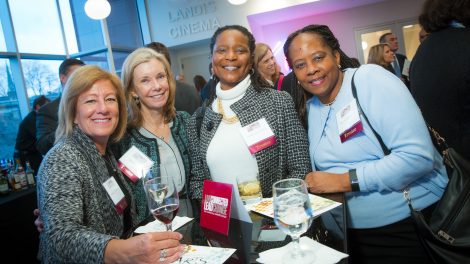
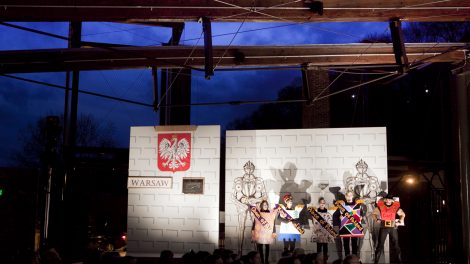
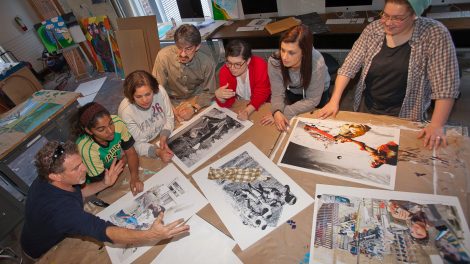
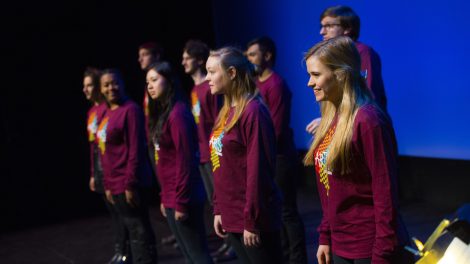
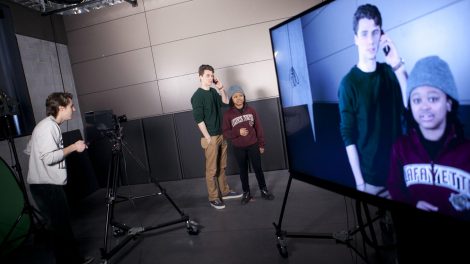
3 Comments
Comments are closed.